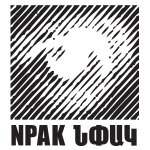He has two antagonists: the first presses him from behind, from the origin. The second blocks the road ahead. He gives battle to both. To be sure, the first supports him in his fight with the second, for he wants to push him forward, and in the same way the second supports him in his fight with the first, since he drives him back. But it is only theoretically so. For it is not only the two antagonists who are there, but he himself as well, and who really knows his intentions? His dream, though, is that some time in an unguarded moment and this would require a night darker than any night has ever been yet he will jump out of the fighting line and be promoted, on account of his experience in fighting, to the position of umpire over his antagonists in their fight with each other. ( F.K. )
Until recently, artistic gesture has been one of few efficient ways for political protest in Armenia. However, artists who were actively involved in fighting the authoritarian regime often stayed out of sight of the audience as the representative function of art institutions was weakened and often minimised. The revolutionary events of May 2018 made artists’ aspirations more tangible, placing them in a vulnerable transitional reality where the framework for discourse is yet to be established. The hierarchic space of recent past – oppressive and marginalising for the artist – was replaced by a space for dialogue where leaving creative passivity and waking up from the power nap became possible.
The Armenian Center for Contemporary Experimental Art (ACCEA), founded in 1992, has from the beginning adopted a critical perspective of the new reality of the independent republic and aspired to change the perception of art practices for audiences and artists alike. For nearly three decades, the ACCEA has been witness to political, social, economic and, most importantly, artistic transformations. Same as artists, it arrived to the present evolving step by step and occasionally halting in its development, but unlike them and as other institutions has not always synchronised with the dynamic of the current.
Is it possible for an art institution in today’s Armenia to take a wakeful, active position and support continuous creative searches as an alternative to hosting large-scale international representative formats? Can an art institution abandon the position of national pride and its corporate strategy in favour of giving voice and providing space to artists and other actors in the artistic field, those living in fragile changing reality, in a gap between past and present?
Together with the collective experience of the recent and the still-unfinished revolution and the history of a particular institution the exhibition seeks to highlight what was previously suppressed and discarded – personal experiences of politically active artists. We will attempt to reveal unexpected discoveries of important moments of the past by highlighting showpieces, rather than accentuating certain periods of time when they were created. The exposition is looking to rethink both – the space of the ACCEA with displayed artworks and the audience experience generated there. Facing today’s reality, but at the same time giving up all speculations about the topic, the exhibition offers works of Armenian artists together with international experiences of other revolutions as alternative ways for building a new reality and practices for their representations.
Artists:
Edgar Amroyan
Arman Grigoryan
Armenak Grigoryan amo
Piruza Khalapyan
Ross Little
Arash Nassiri
Lousineh Navasartian
Ahmet Ogut
Ara Petrosyan
Zhou Tao
Gor Yengoyan
Curator:
Sona Stepanyan
































